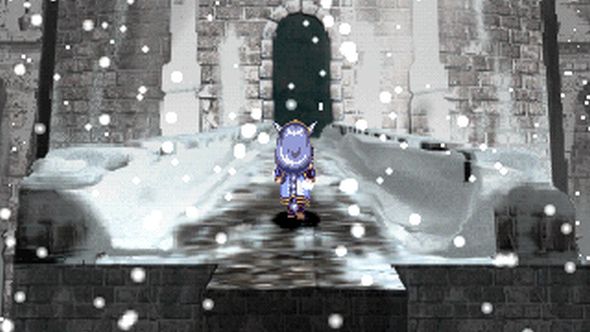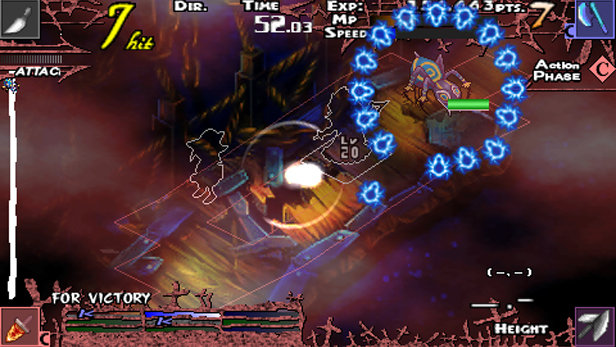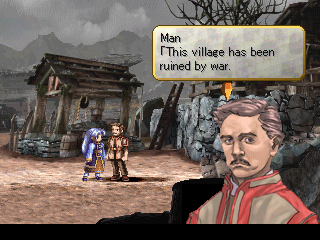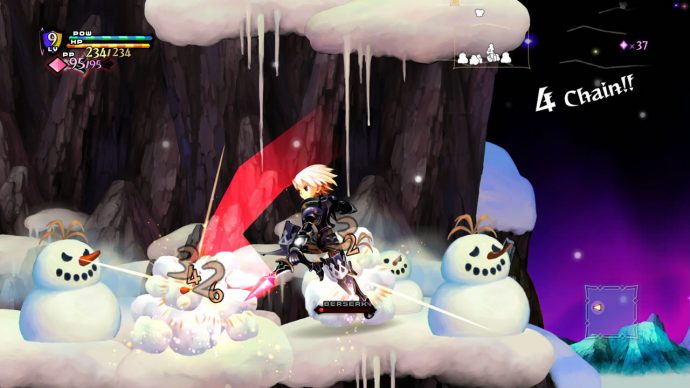8 Japanese games that deserve to find a new home on PC
Looking beyond the obvious
The past year has brought Yakuza, Bayonetta, Ni no Kuni II and many other Japanese series to PC for the first time. In light of that, it's tempting to demand that every classic and everything new and exciting from Japan gets ported over from its original console home.
There's nothing wrong with that, but anyone can ask for Personas 3-5. I'm here to advocate for the swathes of great, older Japanese games that would feel at home on PC, but which haven't yet been canonised. Games which break the mould, and which aren't filled with the usual JRPG tropes. I’ve picked out eight that feel like less obvious choices, all of which deserve to find a new audience on PC.
Mystery Dungeon: Shiren The Wanderer
Chunsoft, 1995 (Super Nintendo), 2008 (Nintendo DS)
Over the past few decades we’ve had countless games where you take on enemy hordes again and again, hoovering up the loot they drop to kit yourself out against ever stronger foes. But Dragon Quest co-creator Koichi Nakamura came up with the Mystery Dungeon series as a more accessible version of Rogue – the venerable text-based dungeon-crawler – years before Diablo, or Borderlands, or Destiny. There’s been a steady stream of releases over the twenty-five years since, and among the best of those were Chunsoft’s own Shiren The Wanderer games. Chunsoft cut back on Rogue’s enemies and its staggering list of items, but introduced linear stories and continuity.
The silent hero Shiren and his best friend, the talking weasel Koppa, adventure through a charming world that strikes just the right balance between anime slapstick and a wistful take on Japanese mythology. The emergent chaos is still there, along with the difficulty. You’re constantly aware that every run is moments from disaster should a monster that you’re not ready for turn up, and while you don’t die per se, defeat still sends you back to the start minus your inventory. The story isn’t just set-dressing, either. Allies can be unlocked who persist over each new attempt, each with their own little side stories. Chunsoft have still only brought one Mystery Dungeon game to PC, but it was an unrelated indie game they slapped with the brand. Any of Shiren’s adventures would be right at home and the very first still holds up today.
Vagrant Story
Squaresoft, 1999 (PlayStation)
People tend to rubbish older consoles’ first attempts at building a world with a meagre handful of polygons, but I still consider Vagrant Story one of the most beautiful games ever created. There’s a unifying artistry to the textures, the colour palette, the characters and the level designs that still shines through, even with the original PlayStation’s wobbly 3D.
On one level Vagrant Story is a straightforward dungeon crawler, albeit with heavy emphasis on some truly esoteric combat, crafting and personalising your equipment. The story is about a lone bounty hunter chasing a fleeing cult leader after a hostage crisis goes badly wrong, with other parties also hot on his trail. There’s not a great deal of logic behind the interlocking systems but the depth and the drip-feed of progression still impress. That visual flair, though, comes across as much more than style over substance.
It was cinematic, before that became a dirty word, and not simply epic for the sake of it. The cutscenes boast some stellar writing and direction, from action movie wisecracks to sharply observed political intrigue, and they’re all rendered in real-time (save one). I’d hold this up as far more adventurous storytelling than anything Hideo Kojima was doing at the time. Fans have been begging for a sequel or remake for years, but I’d happily pay for a straight port of the PlayStation version if that was the only option.
Valkyrie Profile
Squaresoft, 1999 (PlayStation), 2006 (PlayStation Portable) (as Valkyrie Profile: Lenneth)
Most JRPGs try to convince you that if you persevere, then everybody will get the ending they deserve. Not so Valkyrie Profile, which dips at times into outright misery. This is Japanese pop culture taking on Norse myths and legends, with the player cast as one of Odin’s iconic winged warriors. The apocalypse is right around the corner and the All-Father’s army is looking a little thin, so off you go, swooping to and fro across the world map, homing in on prospective recruits. Either these people only just died, or they’re about to, but none of their stories prove especially heartening. Do you hang on to these poor souls to keep your party strong, or ship them off to Valhalla?
As you hack your way through dungeon after dungeon, you remember the protagonist, too, has a backstory she seems to have clean forgotten about. Valkyrie Profile is too melodramatic to be depressing, really, but its relentless parade of could-haves, would-haves and should-haves can still feel exhausting. There’s something captivating about its sheer bloody-minded commitment to maximising pathos, all the same.
The combat is great fun, part turn-based strategy, part fighting game button-mashing, and Motoi Sakuraba never wrote a more fitting score, for such an operatic story. The visuals have dated, but Square Enix have kept the brand alive on smartphones (as a premium release, no less), so presumably they think there’s still money in it.
Breath Of Fire: Dragon Quarter
Capcom, 2002 (PlayStation 2)
Capcom never quite hit the big time with Breath Of Fire, but back in the day these were nice, comfortable JRPGs trading on familiarity and recurring motifs. There’s always a girl, there’s always a dragon (along with hissable villains, line-dancing combat, pleasantly colourful art design and a cheery sense of adventure). Then series veteran Makoto Ikehara decided to turn turn the fifth game, Breath Of Fire: Dragon Quarter, into a grim death march through a post-apocalyptic hellscape – a tonal shift so drastic it effectively killed the series.
In Dragon Quarter, Humans have fled beneath the surface of a ruined planet, eking out a pitiful existence in a rigidly stratified society deep underground. The protagonist stumbles across a terrible experiment: a young girl bred to be a living air filter in the hope of staving off this crumbling, polluted world’s inevitable collapse.
Along with a friendly resistance fighter, our hero deserts his posting to accompany the girl on a seemingly futile climb towards the “sky”. Long before Dead Rising or Dark Souls, Dragon Quarter encouraged you to die and restart repeatedly in the face of seemingly impossible odds, patiently building your stats and unlocking more of the narrative with each new playthrough. Despite the difficulty, it also offered a win button, a super-powered transformation that potentially made any battle a formality but which killed the hero if you abused it. It’s a game I’d say richly deserves another shot at success. The clunky PlayStation 2 3D feels dated, but the roguelike mechanics and that mournful, almost elegiac storyline are practically contemporary.
P.N. 03
Capcom, 2003 (Nintendo GameCube)
The “Capcom Five” project was a rare case of a third-party developer throwing its weight behind a Nintendo console long before the Switch, and aimed to bring five Capcom games exclusively to the struggling GameCube. The project fell flat when one was cancelled, three were ported to the PlayStation 2 and one of those, Resident Evil 4, was such a success it arguably eclipsed all the others. Only P.N.03 remained exclusive to the GameCube. A literal cash grab, largely intended to shore up Capcom’s finances, Resident Evil director Shinji Mikami came up with a third-person shooter so perversely different to anything else the publisher had put out that it ended up a critical and commercial failure.
The tank controls, in line with classic Resident Evil games, emphasise slow and considered play rather than frantically hammering out combos. The heroine’s animation reinforces how combat is a dance, where you watch the enemies’ movements then launch into action as if you’re following stage directions, and – ideally – slide to a halt at the end of the routine without a scratch on you. Mikami went on to build on many of the ideas and the design language with Vanquish for Platinum Games, but there’s an elegance to the original once you start to get the hang of it which few other games have ever matched. Screenshot artist Duncan Harris (sometimes of this parish) produced a gallery for P.N.03 which shows that gorgeous stark white minimalism still holds up. A remaster would be nice, but a simple resolution bump would almost bring it up to date.
Tales Of Legendia
Namco, 2005 (PlayStation 2)
The Tales Of... action role-playing games are pretty well established on PC at this point, and despite some glaring missteps publisher Bandai Namco have generally put a fair amount of effort into releasing on the platform. But the one time they dipped into their back catalogue they chose to port the fan favourite Tales Of Symphonia. Tales games have a reputation as comfort food, and Symphonia is about as shop-bought vanilla as JRPGs get. Tales Of Legendia, on the other hand, was a holdout, the last game to use the series’ traditional 2.5D view for combat. It went largely ignored in the long run (especially after the next game, Tales Of the Abyss, was a roaring success) but it’s arguably the best, and the bravest, in the series.
The premise might not seem like much: a runaway soldier and a mysterious girl wash up on a giant floating island where everybody wants the secret she’s carrying. But what starts out as a Saturday morning cartoon marries twists upon twists to some of the smartest, most thoughtful characterisation the genre has ever had. It’s far from perfect – much of the humour fails to land and the lone character of colour is both a noble savage and a literal spear-chucker who’s the butt of everyone’s jokes far too often. But the maturity on display elsewhere still puts the competition to shame. The charming doll-house aesthetic and a stunning score mean it wouldn’t need too much work to stand up to anything else on Steam.
Odin Sphere
Vanillaware, 2007 (PlayStation 2), 2016 (PlayStation Vita, PlayStation 3, PlayStation 4) (as Odin Sphere: Leifthrasir)
Vanillaware have been making games in lush, painterly 2D since the days of the Sega Saturn, with a vibrant house style that riffs on everything from classical Japanese woodblock prints to the Pre-Raphaelites to Frank Frazetta. Later releases pushed this to ever more lurid extremes (Dragon’s Crown, their tribute to the glory days of four-player co-operative arcade games, is infamous for its wildly stylised player characters and some pretty brazen fan service). But going back to Odin Sphere, the game that put them on the map, what surprises me most is how restrained it is. While it’s basically a side-scrolling brawler with skill trees, stat boosts and crafting under the hood, the writing is as studied as any of the classic PC RPGs.
Five characters’ stories intertwine in a fantasy kingdom on the brink of apocalypse, but it’s less the scope and scale that impresses, more the flawed humanity of the cast. They bicker and squabble with passion, and frequently make the wrong decisions as a result, ones they can never quite take back. Calling it Shakespearian doesn’t seem like a lazy superlative; this is a world away from the typical JRPG’s upward march to glory. No empty titillation here, either. There are some scanty costumes and exaggerated anatomy but the female characters are still given considerably more agency than the norm. Atlus already remastered the game for the current console generation as Odin Sphere: Leifthrasir – a PC port would hardly be a great stretch.
Knights In The Nightmare
Sting, 2008 (Nintendo DS), 2009 (PlayStation Portable)
Sting Entertainment have been toiling away quietly on the margins of the industry since the early nineties, with a back catalogue that’s part work-for-hire, part passion projects. Several of their games, known as the Department Heaven series, share the same epic fantasy universe and the strangest of these is arguably Knights In The Nightmare. Even compared to other genre mashups, Knights still takes some explaining. It’s a turn-based strategy game played on small, abstract grids, but your units have extremely limited movement, and while you’re only a cursor the enemies will still intermittently attack you in a bullet hell mini-game, and repeatedly getting hit means the end of the round, but that’s not necessarily the end of the fight because every round also sees you trying to play tic-tac-toe with your accumulated kills which is how you actually pass the level, and, and…
Even completing the tutorial feels like an achievement, inasmuch as you start to think “How am I ever going to keep all this straight?” Some of it is smoke and mirrors. Many of the stats arguably become superfluous over time. But there’s still little, if anything quite like positioning troops and wielding their attacks as best you can while dodging fountains of neon projectiles. It started out on DS but there was a PSP port, so it can definitely work on a single screen. I doubt something this esoteric would ever draw a huge crowd on PC, but I’d imagine it would find some very dedicated fans.
Thanks to Moby Games for the screenshots.



















